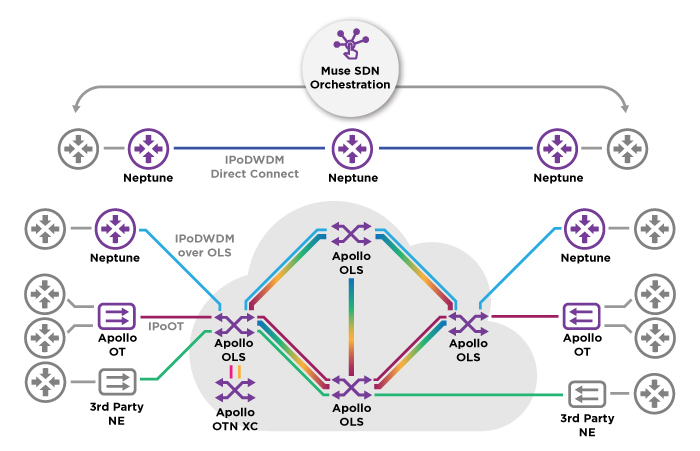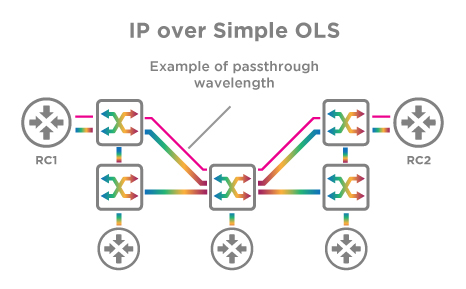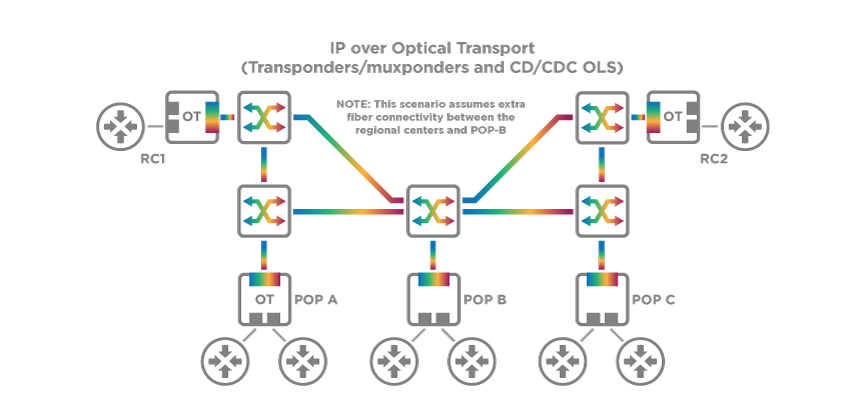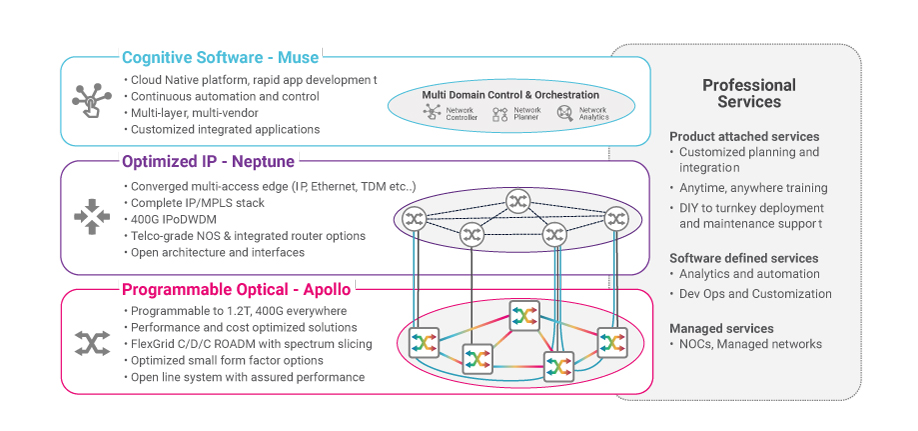For years, the debate has been IPoDWDM versus IPoOT (optical transport). At Ribbon, we have concluded that it is both! The evolution of technologies for optical transmission at 400G and above, wavelength routing, and network control now allow tailoring integrated IP Optical solutions that optimize for the best balance of first cost, performance and operational flexibility. There is no single best approach. Best solutions depend on application details and customer preferences. Sometimes this means integrating DWDM transmission directly into IP routers, and other times it means using optical transport. Indeed, many networks will combine multiple approaches. Ribbon’s IP Wave architecture enables tailoring IP Optical solutions to networks and organizations by using individually or combining three approaches:
Ribbon’s IP Wave architecture enables tailoring IP Optical solutions to networks and organizations by using individually or combining three approaches:
- IPoDWDM Direct Connect
- IPoDWDM over OLS
- IP over Optical Transport (OT)
The WP discusses the relative merits of these approaches to help guide in deciding what is best for your network.

To begin, it is important to recap the capabilities and limitations of the enabling 400G+ transceiver technologies for the approaches. The table summarizes the primary transceiver types for transporting dominant 100GbE and growing 400GbE client traffic.
Enabling Technologies
To begin, it is important to recap the capabilities and limitations of the enabling 400G+ transceiver technologies for the approaches. The table summarizes the primary transceiver types for transporting dominant 100GbE and growing 400GbE client traffic.
| Attribute | Embedded Modules | CFP2 DCO | QSFP-DD |
|---|---|---|---|
| Relative cost | $$ | $ | $ |
| Form / Ecosystem | Vendor proprietary | Multi-vendor pluggable | Multi-vendor pluggable |
| Volume / Power | >200 cm³ / 60W+ | 55 cm³ / 25W | 14 cm³ / 15–20W |
| Signal launch | 0 dBm (1 mW) | 0 dBm (1 mW) | −10 dBm (0.1 mW) |
| Optimization / Rate | Performance-optimized 400G; 800G–1.2T | Power/cost-optimized up to 400G | Power/cost-optimized up to 400G |
| Typical application | Transponders/muxponders; CD/CDC ROADM networks | Transponders/muxponders; CD/CDC ROADM networks | IP direct connect; simple ROADM networks |
| Interoperability | Not interoperable | Interoperable (OpenROADM MSA, 400G ZR+) | Interoperable (OIF 400ZR, OpenZR+ MSA, 400G ZR+) |
The Three Approaches to IP Optical
Sample Network
We use a simple sample network as a common basis to discuss the three approaches. IP services traffic aggregates at a number of POPs, and communicates with two regional centers for cloud applications and Internet connectivity. The regional centers are 160km (100 miles) apart, and two fiber rings are available to connect them. This arrangement is convenient for illustrative purposes, and is entirely possible based on topography and the history of when the fiber was laid. The figure on the left shows the traffic density based on user demand. Users in POP-A will communicate primarily with RC1, those in POP-B will communicate evenly, and those in POP-C will communicate primarily with RC2. The regional centers will have a high volume of traffic to synchronize cloud data continuously for business continuity.
IPoDWDM Direct Connect
The routers connect directly with each other using small form factor QSFP-DD pluggable transceivers that consume minimal faceplate space, and support OIF 400ZR or OpenZR+ MSA. The maximum signal rate is 400Gbps, the maximum signal launch power is -10dBm (0.1mW), and there is no OTN framing. Low insertion loss passive multiplexers combine wavelengths onto a fiber. There is no networking at the optical layer. The network can be configured for various topologies like point-to-point, hub-and-spoke, ring, or mesh. If there is a fiber break, recovery is only at the IP routing layer.
In the sample network, all the traffic between RC1 and RC2 must transit through the intermediary routers at the POPs.

IPoDWDM over OLS
This is the same as direct connect, with the addition that an optical line system (OLS) based on ROADMs combines and routes wavelengths under software control. This incorporates any needed amplification and allows wavelengths to “bypass” intermediary nodes, reducing traffic loads and port requirements on intermediary routers. In the sample network, we see how traffic on the red wavelength connects the regional centers, bypassing all the routers in the POPs.
However, the relatively low power -10dBm signal launch power constrains this flexibility, so that bypass is limited to only a few OLS transit or wavelength-passthrough nodes. In addition, the low signal power does not permit using ROADM nodes with advanced CD/CDC (colorless-directionless-contentionless) capabilities, which are required to implement WSON dynamic link restoration upon fiber failures. Effectively, only simple OLS can be used.

IP over Optical Transport
Routers connect to a distinct optical transport network using gray optics. The optical network uses transponders and muxponders to encapsulate the IP payloads onto wavelengths using OTN framing and to transmit the wavelengths with signal strengths up to 0dBm (1mW). These transponders and muxponders are based on two main types of transceivers: proprietary transceivers supporting wavelengths up to 800Gbps today and 1.2Tbps coming soon, and on standard pluggable transceivers based on the 400GZR+ OpenROADM MSA for wavelengths up to 400Gbps. This OTN transport layer combines with an unconstrained CD/CDC OLS to provide a flexible and rich optical layer that enables multiple capabilities. Some of these are shown in the sample network diagram.
- A virtually unlimited number of nodes a wavelength can transit for router bypass.
- WSON dynamic link restoration upon fiber failures, based on advanced CD/CDC functionality at ROADM nodes.
- An ability to support alien wavelengths without constraints.
- An ability to provide advanced spectrum sharing features to optical network partners.
- Layer 1 optical encryption (e.g., some webscale providers and many enterprises require that all links are encrypted).
- An ability to disaggregate and use best-of-breed optical transport technology without any router modifications.
- An ability to add OTN switches at strategic locations for additional flexibility in grooming and switching IP traffic among wavelengths.
A multivendor SDN orchestrator with in a unified multilayer view extracts the most value from this approach by coordinating between the IP services and the flexible optical transport.

Relative Value Considerations
To reiterate, no single approach is inherently best. Multiple factors are involved such as the mission, size and complexity of the network, as well as the operational and organizational philosophies of the network operator. The analysis below lays out considerations for each approach for six factors.
| Detail | IPoDWDM Direct Connect | IPoDWDM over Simple OLS | IP over Optical Transport |
|---|---|---|---|
| First Cost | Appears economical (no optical layer) but needs larger routers and more optics due to through-traffic. | OLS adds some cost but reduces router ports via limited bypass (constrained by launch power). | Higher first cost for distinct optical layer; enables extensive bypass and port efficiency. |
| Ease of Operation | Single-layer architecture is intuitively easiest to operate. | Adds OLS complexity; mitigated by integrated management. | Typically two domains (IP & Optical); SDN orchestration can unify operations. |
| Service Availability (Robustness) | Recovery only at IP layer; depends on interconnectivity and headroom. | Lower robustness than Direct Connect (limited bypass; no optical-layer restoration). | Best: combines IP restoration with optical protection switching and dynamic WSON restoration. |
| Latency Performance | Poorest aggregate latency—most hops in hop-by-hop architecture. | Medium—some bypass removes unnecessary hops. | Best—multilayer optimization eliminates unnecessary hops. |
| Enterprise Services | Granular IP QoS/CoS; inefficient for high-capacity optical services; no L1 encryption. | Same as Direct Connect. | Offers optical services in addition to IP; supports Layer 1 optical encryption. |
| Evolvability | Cannot leverage new coherent optics until adapted for routers. | Same as Direct Connect. | Greatest flexibility: IP and optical can evolve independently with best-of-breed tech. |
Ideas for Moving Forward
As the analysis shows, there is much to consider, and there are likely even more non-technical factors like company organization and preferences. As a broad guideline, while it is probably fair to conclude that IPoDWDM best fits simpler networks, while multilayer IPoOT is better suited to networks that are more complex, reality is more complicated. Here are some suggestions on how to move forward.
- “Run the numbers” on different approaches side-by-side using modeling and planning tools. Perform this for both the initial network and a future expanded network based on projected traffic and geographic growth. This provides valuable insights into inflection points, and in particular, can indicate how robust the network is to handling growth and change over time. For example, IPoOT often has a greater first cost, but its transport infrastructure usually absorbs growth more easily.
- Perform “what-if” analyses to test the network’s resiliency to failures. Are there service outages or performance impacts? This may necessitate adding more facilities and ports to the network, which could affect first cost analyses.
- Analyze both the aggregate and outlier performance aspects of the network, such as the latency to nodes most distant from a data center. This can affect an ability to provide specific SLA performance guarantees, and may mandate installing bypass routes.
- In the complex realm of operations, understand how the solution’s control and orchestration platforms integrate into the existing operating infrastructure to minimize ongoing Opex.
Tailoring 400G+ IP Optical Solutions with IP Wave
Ribbon helps network operators overcome the multiple considerations in deciding the optimal way to bring IP and optical together with our “no-agenda” IP Wave approach.
IP Wave is Ribbon’s platform for creating service-driven IP Optical networking solutions that deliver better economics, agility, and customization. IP Wave solutions fuse together optimized hardware and automation software within an open architecture, all under an umbrella of customer collaboration. IP Wave’s holistic framework offers multiple approaches, which we plan, analyze, and tailor with our customers to create integrated IP Optical solutions that best meet network requirements and organizational needs. This could be IPoDWDM or IPoOT, or some mix of the two main approaches, since as we well know, in the realm of IP Optical one size does not fit all.



